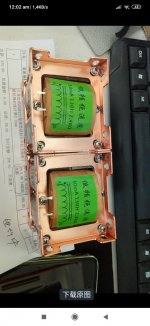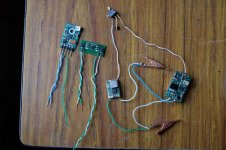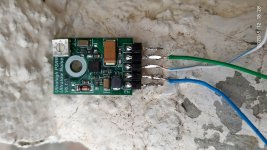Sorry it was a typo error there, instead 2k49 I should write 2k39, my apologies for that. Lets me insist this set a somewhat damping factor, this value my be optimal for my 8 ohm fullrange only. Pic. below is my 2k4 ohm inductor I got today from manufacturer. I suppose I would place not at PCB board, straigt to the amp. binding posts + and -.After some fine tuning in the power supply (Ubib by Salas), today I took another hearing on R14, as tomorrow I will get quotation for the Anode choke, wanting to be certain, I set a new arrangement, free from variables, I was lucky the magical spot was in the range I expected, the new value 2k49. For my 8 ohm speaker, this is.
Jordi
Attachments
Last edited:
Another premium part I find, a bit tricky not a direct replacement. R16 / 200 ohm and C4/100uF can be substituted for a low noise DC to DC reg. board.
I set troaugh the small trimmer an output 18,7v. to fed the Toshiba 2SK170 transistor.
Very interesting!
Which DC-DC are you using?
What voltage is your main PS rail? (29.6V you said?)
This can suit ACA at 23v, as mine. Altrough only rated at 20v, I have not seen any damage. This particular application is no need for heatsink. Ultra low noise 0,8uV.
LT3094 LT3093???RF??ADC??DAC???????????ADI-???
LT3094 LT3093???RF??ADC??DAC???????????ADI-???
Last edited:
Same seller has a higher voltage version, that can reach 4-30v. in, and 0,8-24v. out. But at higher noise, 40mV. Still low noise but not the same. Never tried myself. Another caveat, is missing the small potentiometer, just a place for smd solder.
????DC??????AECQ100????????36V3A LT3045-???
????DC??????AECQ100????????36V3A LT3045-???
That comment about switching noise led me perform a shootout of different DcDc reg, and lucky Tungstenaudio you do, as a first try after setting arrangement with no variables (same crocs and wiring- please see pic attach) was please to notice the small reg in center of image is much better sounding that one on the right posted favourabily two days ago.
Still remain another one (on the left) for comparison, later I will post results again.
The forth in the pic (center left) is a much simple fixed reg to an output 5v. will be interesting to modify as variable, but not sure it's so small, even wiith magnifing lens, not confident in success.
Still remain another one (on the left) for comparison, later I will post results again.
The forth in the pic (center left) is a much simple fixed reg to an output 5v. will be interesting to modify as variable, but not sure it's so small, even wiith magnifing lens, not confident in success.
Attachments
Well is astounding how easy is listen to sound differences between boards, no question the winner in the chart is that below, I shoot as much close I can. Don't wants further reseach on modification other such an small boards. Hopefully I have a pair, so this goes regulated to 18,7v to rhe ACA amp, powering a true Toshiba 2sk170, not this fakes that Reihard-Germany sell as original (or beware midleman)
Attachments
Tungsten: I understand what changing the feedback network part values does - but what is the result of lowering the resistance of the R3/R4 parallel pair? What performance parameter is it intended to change? Just curious to read a technical explanation before I try it!
Thanks for your mod work and sharing it with us!
Thanks for your mod work and sharing it with us!
Lowering the resistance of R3/R4 increases the quiescent current through the output stage, and changes the balance of drive current between the active current source and Q1. I found it improved the dynamics with my speakers. I also like to use IRFP140 Mosfets and a higher supply voltage.
I’ll be getting back to some experiments with SMPS power and a capacitance multiplier for each channel. I happen to have a pair of MeanWell HRP-200 24V that are available.
I’ll be getting back to some experiments with SMPS power and a capacitance multiplier for each channel. I happen to have a pair of MeanWell HRP-200 24V that are available.
Lowering the resistance of R3/R4 increases the quiescent current through the output stage, and changes the balance of drive current between the active current source and Q1. I found it improved the dynamics with my speakers. I also like to use IRFP140 Mosfets and a higher supply voltage.
Tungsten:
Thanks very much for the quick reply! I understand that the same voltage drop across a lower resistance = higher current. I guess what I was driving at is - does this new bias point represent a null point in the overall distortion curve for the ACA? Or perhaps a change in the overall distribution of harmonic components? More 2nd, perhaps? Did you happen to measure it after the changes to see if anything was observable, or was it only a listening test (which is 100% valid, of course!).
As to the IRFP 140 substitution, do you recommend this swap in all cases - or only for those who are using higher-voltage power supplies? I'm running 24 VDC on mine.
Thanks again!
Last edited:
My early evaluations of the ACA modifications were all done by ear. After I had finished the linear supply versions in the Hafler chassis, I made some simple distortion measurements, but was still mostly evaluating sound quality by ear.
Having two amps that are very similar (ACA-220 v1 and v2) makes it easier to evaluate how the sound of the amp is affected by changes to the implementation. This was especially relevant when I tried substituting a 150W, 27V SMPS. That initial trial was good from a low PSU noise point of view, but was lacking in bass support in the lower octave. Now that I have more experience with PSU design including capacitance multipliers, I have some new things to try with an SMPS as the base source of power, followed by independent CapMx filtration per channel.
Having two amps that are very similar (ACA-220 v1 and v2) makes it easier to evaluate how the sound of the amp is affected by changes to the implementation. This was especially relevant when I tried substituting a 150W, 27V SMPS. That initial trial was good from a low PSU noise point of view, but was lacking in bass support in the lower octave. Now that I have more experience with PSU design including capacitance multipliers, I have some new things to try with an SMPS as the base source of power, followed by independent CapMx filtration per channel.
done messing around
I am done tinkering with my amp camp. Running at 29.5 volts on the rails, with 15 volts on the idle. Have 10K on the input resistance, 330K + 27pf silver mica cap parallel on the feedback, and 1.4K for R14, and it sounds very nice. I now prefer the amp camp over my Tubelab Single ended.
I think that the amp camp has a fuller sound, and is dead quiet since I split up the power supply into 2 cases with the 25V + 25V transformer and rectifiers and 27,200uf filter reserve and 10mH choke for each channel in case one. This is connected to the amp proper in the second case via
the 30 DC volts a channel power cord. Amp proper has a 33,000uf cap per channel, and the 2 amp cards, thats all. Room for a clean layout.
Time to just enjoy the music!
I am done tinkering with my amp camp. Running at 29.5 volts on the rails, with 15 volts on the idle. Have 10K on the input resistance, 330K + 27pf silver mica cap parallel on the feedback, and 1.4K for R14, and it sounds very nice. I now prefer the amp camp over my Tubelab Single ended.
I think that the amp camp has a fuller sound, and is dead quiet since I split up the power supply into 2 cases with the 25V + 25V transformer and rectifiers and 27,200uf filter reserve and 10mH choke for each channel in case one. This is connected to the amp proper in the second case via
the 30 DC volts a channel power cord. Amp proper has a 33,000uf cap per channel, and the 2 amp cards, thats all. Room for a clean layout.
Time to just enjoy the music!
It took me a while to get a quiet linear power supply. Had no problems using the 24 volt kit brick, but was challenged to get the linear supply to work for me. It seems that my success was tied to getting the transformer away from inside the amp itself, but perhaps splitting things up made it simpler to avoid creating a ground loop. When the space inside the case gets so cluttered, it made it impossible for me to lay things out cleanly, which is obviously very important in a quiet supply. I used to give my tube amp the edge in comparison to the amp camp, but now the amp camp is clearly the more favorable to my ears in every way! The amp camp is an amazing creation, and a big Thank You to Papa Pass 
The more I work with these and other amplifiers, the more I'm convinced that an excellent power supply is the foundation for excellent sound.

I quite agree.
My early evaluations of the ACA modifications were all done by ear. After I had finished the linear supply versions in the Hafler chassis, I made some simple distortion measurements, but was still mostly evaluating sound quality by ear.
Having two amps that are very similar (ACA-220 v1 and v2) makes it easier to evaluate how the sound of the amp is affected by changes to the implementation. This was especially relevant when I tried substituting a 150W, 27V SMPS. That initial trial was good from a low PSU noise point of view, but was lacking in bass support in the lower octave. Now that I have more experience with PSU design including capacitance multipliers, I have some new things to try with an SMPS as the base source of power, followed by independent CapMx filtration per channel.
That’s exactly what I’m after right now!
I’m looking to build a 4 board chassis with your changes for a stereo system (2x bridged). I’m looking to use SMPS with a CapMX. This will be on a separate chassis. Rudi at some point had these PCBs for sale. I just PMd him. Hopefully he still got some!
... and 1.4K for R14, and it sounds very nice.
...Time to just enjoy the music!
At some point you have to stop tinkering and start enjoying.
Question for you - How did you decide on R14 value? Did you look at the THD or do it by ear? I presume you were trying to get the most pleasing mix of H2 and H3, correct?
R14 selection
Hi Mr. Kking
My selection was based on a post by JOIMONF, where he said,
Quote: Originally Posted by JOIMONF
R14, 1kohm, is critical for sound quality, and must be upgraded to maximum quality available. I heard increase sound quality using Riken resistor, then further upgrade with Vishay naked TX2352, but the definitive component here is an inductor (grid choke). I tried different values and found 2k7 to be ideal (for my 8 ohm speaker).
After some fine tuning in the power supply (Ubib by Salas), today I took another hearing on R14, as tomorrow I will get quotation for the Anode choke, wanting to be certain, I set a new arrangement, free from variables, I was lucky the magical spot was in the range I expected, the new value 2k49. For my 8 ohm speaker, this is.
Jordi
When I looked at my part stash, I had a 1.4K Dale resistor that was better quality than the 1K default R14, so I decided to try that in place as a conservative change. I did not do an intensive before and after test, but I was assuming that a better quality resistor in that place would not be adverse. I didn't have any resistors of quality any closer to the suggested value of 2K49, but my speakers are 8 ohm also.
I do not have a scope, so my comments are just from listening to my open baffle speakers, and it sounded very nice so I left it at 1.4K. Between the change of the feedback resistor to 330K plus the 27pf in parallel and the 1.4K for R14, I can say positively that my Amp Camp now exceeds the sound quality of my Tubelab Single ended tube amp, and before the tubes had the lead over the Amp Camp, though it was close. I am really enjoying the sound quality now present with the changes.


Hi Mr. Kking
My selection was based on a post by JOIMONF, where he said,
Quote: Originally Posted by JOIMONF

R14, 1kohm, is critical for sound quality, and must be upgraded to maximum quality available. I heard increase sound quality using Riken resistor, then further upgrade with Vishay naked TX2352, but the definitive component here is an inductor (grid choke). I tried different values and found 2k7 to be ideal (for my 8 ohm speaker).
After some fine tuning in the power supply (Ubib by Salas), today I took another hearing on R14, as tomorrow I will get quotation for the Anode choke, wanting to be certain, I set a new arrangement, free from variables, I was lucky the magical spot was in the range I expected, the new value 2k49. For my 8 ohm speaker, this is.
Jordi
When I looked at my part stash, I had a 1.4K Dale resistor that was better quality than the 1K default R14, so I decided to try that in place as a conservative change. I did not do an intensive before and after test, but I was assuming that a better quality resistor in that place would not be adverse. I didn't have any resistors of quality any closer to the suggested value of 2K49, but my speakers are 8 ohm also.
I do not have a scope, so my comments are just from listening to my open baffle speakers, and it sounded very nice so I left it at 1.4K. Between the change of the feedback resistor to 330K plus the 27pf in parallel and the 1.4K for R14, I can say positively that my Amp Camp now exceeds the sound quality of my Tubelab Single ended tube amp, and before the tubes had the lead over the Amp Camp, though it was close. I am really enjoying the sound quality now present with the changes.


- Home
- Amplifiers
- Pass Labs
- ACA amp with premium parts


